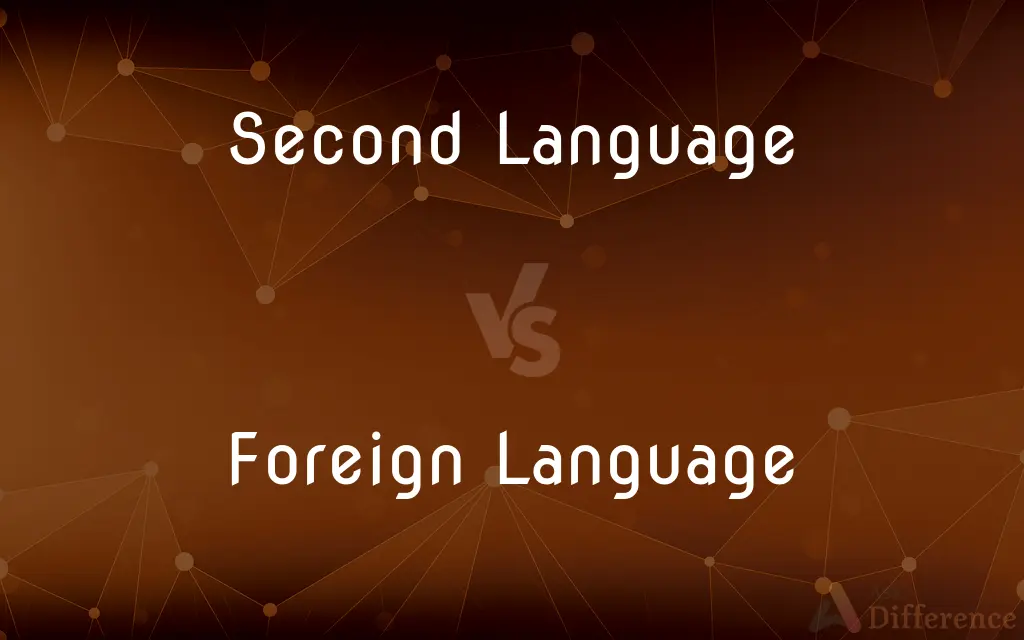Second Language vs. Foreign Language — What's the Difference?
By Tayyaba Rehman — Published on January 14, 2024
A second language is learned and used in an environment where it is spoken, while a foreign language is learned in a region where it's not widely spoken.

Difference Between Second Language and Foreign Language
Table of Contents
ADVERTISEMENT
Key Differences
A Second Language is any language learned after one's native language and is used regularly in the learner's community or country. It is often acquired due to geographical, social, or professional reasons. For example, English learned and used daily in India would be considered a second language. A Foreign Language, conversely, is a language that is not generally spoken in the learner's immediate community or country. It's typically learned for personal interest, academic purposes, or global communication. For instance, learning Japanese in the United States is considered learning a foreign language.
Learning a Second Language often involves immersion, where learners are exposed to the language in everyday situations, facilitating practical usage and understanding. This environment provides continuous learning opportunities, making it more about practical communication than formal study. In contrast, learning a Foreign Language usually happens through structured classes or self-study, where exposure to the language is limited to educational settings, resulting in a more academic or theoretical understanding.
The proficiency in a Second Language can often reach a near-native level due to the immersion and necessity of use in daily life. The learner’s proficiency in a Foreign Language, however, may vary widely based on the quality and extent of education and exposure.
In a Second Language scenario, cultural assimilation is common as the language is part of the learner's social environment. For a Foreign Language, cultural exposure is often limited to academic contexts, unless the learner seeks out additional cultural experiences related to the language.
The motivation for learning a Second Language is often practical necessity, such as living in a region where the language is spoken, or for professional reasons. In contrast, learning a Foreign Language is often motivated by personal interest, academic requirements, or to broaden one's cultural understanding.
ADVERTISEMENT
Comparison Chart
Environment of Learning
Learned and used where it is spoken
Learned in a region where it's not widely spoken
Mode of Acquisition
Often through immersion and practical use
Typically in structured educational settings
Proficiency Level
Can reach near-native due to regular use
Varies, often limited by educational exposure
Cultural Integration
Often includes cultural assimilation
Limited to academic or self-sought experiences
Primary Motivation
Practical necessity, social or professional reasons
Personal interest, academic goals, cultural exposure
Compare with Definitions
Second Language
Includes cultural aspects of the language-speaking community.
Learning Arabic as a second language in Egypt helped me understand local customs.
Foreign Language
Usually motivated by personal interest or global communication.
I chose Japanese as a foreign language for my love of Japanese culture.
Second Language
A language learned and used in a region where it is spoken.
In Quebec, French is a second language for many English-speaking Canadians.
Foreign Language
A language not commonly spoken in the learner's immediate environment.
Italian is a popular foreign language choice in American high schools.
Second Language
Can be necessary for social integration and communication.
My cousin learned Spanish as a second language when she moved to Spain.
Foreign Language
Often learned in academic settings or through self-study.
He studied Russian as a foreign language at the university.
Second Language
Often acquired through immersion and daily use.
Immigrants in the U.S. frequently learn English as a second language.
Foreign Language
Cultural exposure is often academic or theoretical.
My foreign language class included cultural lessons about France.
Second Language
Proficiency can be similar to a native speaker.
She speaks German as a second language almost fluently.
Foreign Language
May have limited practical use in daily life.
Learning Mandarin as a foreign language in Brazil is more academic than practical.
Common Curiosities
What is a second language?
A language learned after one's native language, often used within the community.
Can a foreign language become a second language?
Yes, if a learner moves to an area where the foreign language is widely spoken.
What constitutes a foreign language?
A language learned that is not commonly spoken in the learner's environment.
Why do people learn a second language?
For practical reasons like living in a new country or professional requirements.
Why might someone choose to learn a foreign language?
For personal interest, academic goals, or to appreciate a different culture.
How do proficiency levels differ between a second and a foreign language?
Proficiency in a second language can reach near-native levels, while in a foreign language, it varies based on educational exposure.
What are the benefits of learning a foreign language?
It broadens cultural understanding and can enhance global communication skills.
Is it easier to learn a second language through immersion?
Generally, yes, as immersion provides natural and frequent language exposure.
Can one be fluent in a foreign language?
Yes, with dedicated study and practice, one can achieve fluency.
Do employers value foreign language skills?
Yes, foreign language skills are often valued in globalized and multicultural work environments.
What challenges come with learning a foreign language?
Limited practical use and lack of immersion can make learning more challenging.
Are second language learners more culturally assimilated?
Typically, yes, as they are often part of the language-speaking community.
Do second language learners have a different accent?
They might initially, but many can achieve an accent similar to native speakers.
Is a second language always necessary for living in a new country?
Not always, but it is highly beneficial for social and professional integration.
How important is cultural learning in foreign language education?
Cultural learning is crucial as it enhances understanding and appreciation of the language.
Share Your Discovery

Previous Comparison
System Software vs. Application Software
Next Comparison
Resting Potential vs. Action PotentialAuthor Spotlight
Written by
Tayyaba RehmanTayyaba Rehman is a distinguished writer, currently serving as a primary contributor to askdifference.com. As a researcher in semantics and etymology, Tayyaba's passion for the complexity of languages and their distinctions has found a perfect home on the platform. Tayyaba delves into the intricacies of language, distinguishing between commonly confused words and phrases, thereby providing clarity for readers worldwide.














































